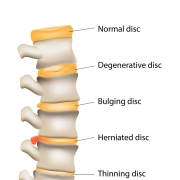Patients tend to panic a little when the term “degeneration” is used to describe the condition of their vertebral discs. Degenerative disc disease sounds even worse, like a progressive, life-threatening disease, but we promise there’s no need to become overly distressed. In fact, disc degeneration is a natural part of aging and the condition can vary dramatically in nature, severity and pain.
Dr. Mark Giovanini of NeuroMicroSpine wants patients to understand that disc degeneration can describe an array of spinal conditions and that if you hear this term, you may want to consider seeing a specialist like Dr. Giovanini to manage and/or treat it.
Disc degeneration may be linked to some of the following spinal conditions:
- Spinal Stenosis: a condition that compresses the spinal nerve roots and/or spinal cord, causing pain, weakness, numbness, etc.
- Osteoarthritis (of the spine): the breakdown of cartilage between facet joints in the spine. Symptoms include pain and stiffness in the area affected.
- Spondylolisthesis: a condition where the degenerated facet joints become mechanically ineffective, causing one vertebral body to slip forward on the other. Patients may feel lower back and/or leg pain and weakness in their legs.
Degenerative disc disease can cause inflammation, eventually causing pain and sometimes lower back and neck muscle spasms.  These spasms may come from abnormal micromotion instability. We’ll explain: when the annulus (outer rings of the intervertebral disc) wears down, it has a difficult time resisting motion in the spine. Muscle spasms are the body’s attempt to stabilize the spine, which can cause significant pain.
These spasms may come from abnormal micromotion instability. We’ll explain: when the annulus (outer rings of the intervertebral disc) wears down, it has a difficult time resisting motion in the spine. Muscle spasms are the body’s attempt to stabilize the spine, which can cause significant pain.
Other symptoms may include: worsening pain from sitting, bending and twisting or chronic (long-term) pain. Walking, lying in a reclining position or lying down with a pillow under your knees may relieve some level of pain and stress on the spine.
Common nonsurgical treatment options could include physical therapy, heat and ice packs, medications (NSAIDs and prescription medications), epidural steroid injections. If you’re looking for long-term pain relief though, Dr. Giovanini may recommend a surgical solution.
Generally speaking, an artificial disc replacement or spinal fusion may be suggested to restore the mobility and normal functioning of the spine and reduce pain symptoms. Talk to Dr. Giovanini about the possibility of relieving pain through a minimally invasive spine surgery.
For more information on minimally invasive spine surgery or to make an appointment with Dr. Giovanini, please call (850) 934-7545 or visit http://www.neuromicrospine.com/request-appointment.
We hope to see you soon!
The advice and information contained in this article is for educational purposes only, and is not intended to replace or counter a physician’s advice or judgment. Please always consult your physician before taking any advice learned here or in any other educational medical material.
©NeuroMicroSpine, 2015
©Medical Marketing Solutions, 2015
